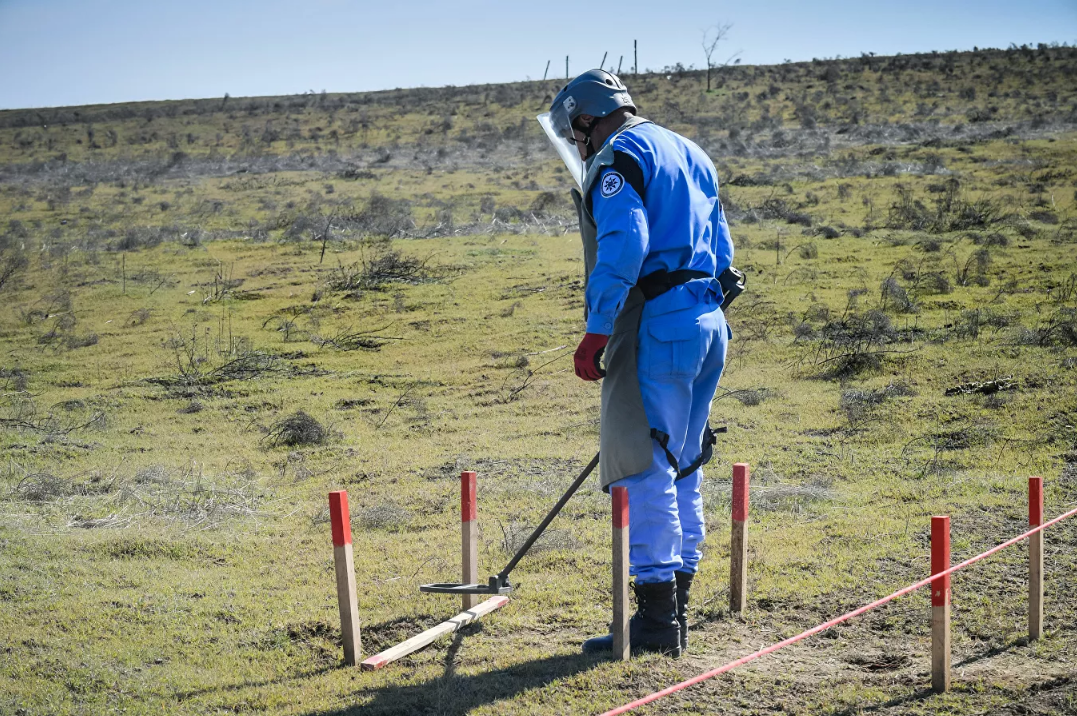Azerbaijan National Agency for Mine Action (ANAMA) said it had cleared almost 6,000 hectares (14,800 acres) of land in Azerbaijan’s Karabakh region from landmines and unexploded ordnances since last November.
Between November 10, 2020, and October 31, 2021, a total of 10,200 antipersonnel mines, 4,329 anti-tank mines, and 12,436 unexploded ordnances have been found and neutralized in the territories liberated from Armenian occupation, according to data released by the agency.
Azerbaijan National Agency for Mine Action or ANAMA leads the ongoing mine clearance operations in the liberated territories. The agency deployed its specialists and cutting-edge machinery of the Turkish, British, and Slovak production there shortly after the hostilities ended in November 2020.
The Karabakh (Garabagh) region, an internationally recognized territory of Azerbaijan, has been mined heavily during their nearly 30-year-long occupation by Armenia since the early 1990s. Armenia kicked off full-blown military aggression against Azerbaijan following the Soviet Union’s dissolution in 1991. The bloody war lasted until a ceasefire in 1994 and saw Armenia occupying 20 percent of Azerbaijan’s internationally recognized territories. Over 30,000 Azerbaijanis were killed, and one million were expelled from those lands in a brutal ethnic cleansing policy carried out by Armenia.
On September 27, 2020, the decades-old conflict between the two countries spiraled after Armenia’s forces deployed in the occupied Azerbaijani lands shelled military positions and civilian settlements of Azerbaijan. During the counter-attack operations that lasted 44 days, Azerbaijani forces liberated over 300 settlements, including the cities of Jabrayil, Fuzuli, Zangilan, Gubadli, and Shusha, from nearly 30-year-long illegal Armenian occupation. The war ended in a tripartite statement signed on November 10 by Armenia, Azerbaijan, and Russia. Under the statement, Armenia also returned the occupied Aghdam, Kalbajar, and Lachin districts to Azerbaijan.
Shortly after the war, the Azerbaijani government started extensive mine-clearing operations in the once occupied lands to revive the region and bring the internally displaced persons back to their native lands.
Demining operations, however, face many challenges due to Armenia’s refusal to hand over the maps of the areas where the landmines are located.
So far, Azerbaijan has obtained from Armenia a small portion of the minefield maps of the once occupied Aghdam, Fuzuli, and Zangilan districts, which reportedly identify the coordinates of a total of 189,000 anti-tank and anti-personnel mines. In exchange for maps, Azerbaijan released 30 Armenian saboteurs detained in Azerbaijani territory after the ceasefire. Later, Azerbaijan’s President Ilham Aliyev said the accuracy of these maps did not exceed 25 percent. Officials in Baku are convinced that the maps hidden by Armenia could help neutralize at least one million landmines planted in the once occupied Azerbaijani lands.
The Azerbaijani authorities have repeatedly stated that minefields remain one of the main obstacles to reconstruction and humanitarian projects in the liberated territories. Since November 10, 2020, 167 Azerbaijani citizens have been trapped by landmines, of which 33 died. On June 4, 2021, two Azerbaijani journalists and a government official were trapped in a fatal mine explosion in the liberated Kalbajar district.
ANAMA officials noted that the neutralization of unexploded ammunition, warheads, and missiles in the combat zones under current circumstances could take 5-6 years, while it is about 10-13 years for the mined areas.







 Armenian sappers commenced on Monday mine-clearance operations in the territories adjacent to the Saint Mary Church in village of Voskepar (Armenia...
Armenian sappers commenced on Monday mine-clearance operations in the territories adjacent to the Saint Mary Church in village of Voskepar (Armenia...
 Russian Foreign Minister Sergei Lavrov has reasserted that Moscow has no intentions to stop the fighting in Ukraine, even if peace talks commence.
Russian Foreign Minister Sergei Lavrov has reasserted that Moscow has no intentions to stop the fighting in Ukraine, even if peace talks commence.
 Iran has refuted reports of alleged damage to Shimon Peres Negev Nuclear Research Centre located southeast of Dimona, Israel, during the recent air...
Iran has refuted reports of alleged damage to Shimon Peres Negev Nuclear Research Centre located southeast of Dimona, Israel, during the recent air...
 Iran’s Foreign Minister, Hossein Amir-Abdollahian, has labeled a foiled Israeli drone attack in certain parts of the country as a "failure" for Isr...
Iran’s Foreign Minister, Hossein Amir-Abdollahian, has labeled a foiled Israeli drone attack in certain parts of the country as a "failure" for Isr...



